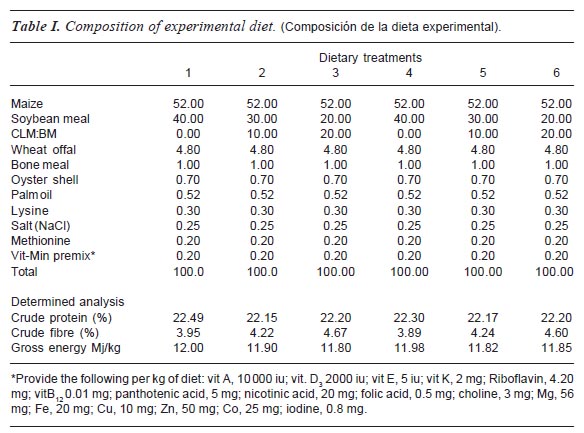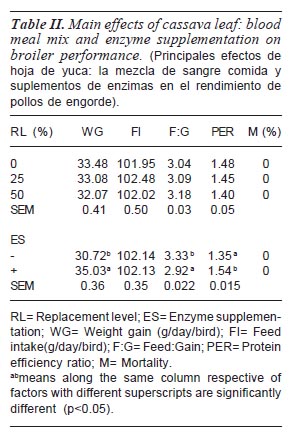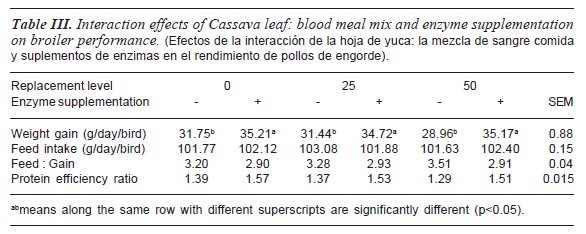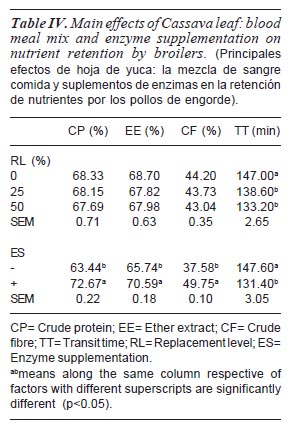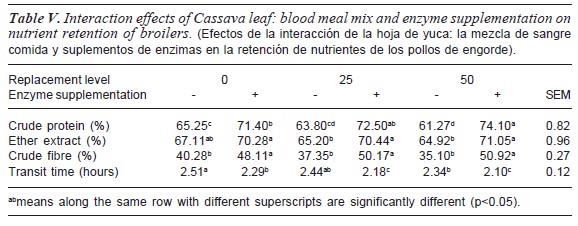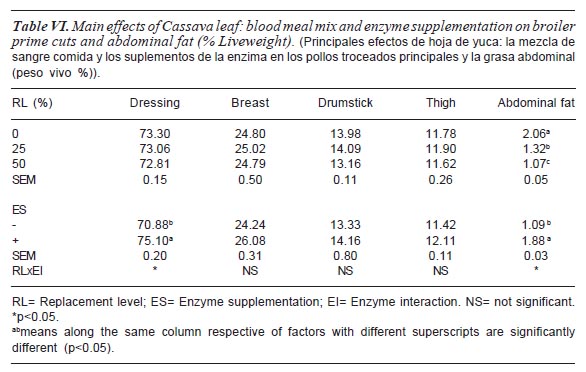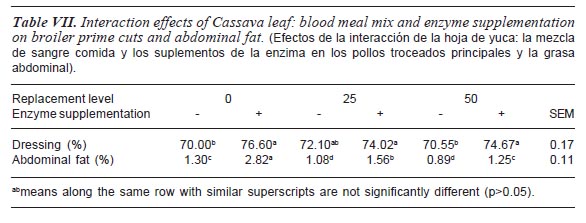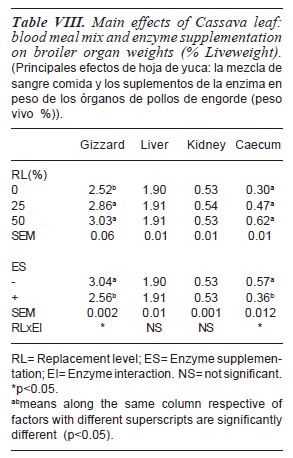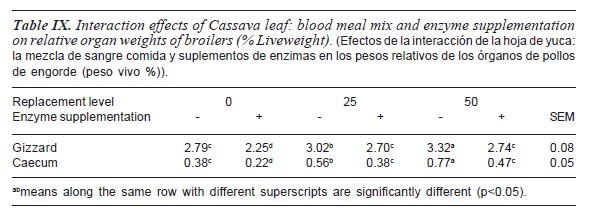Mi SciELO
Servicios Personalizados
Revista
Articulo
Indicadores
-
 Citado por SciELO
Citado por SciELO -
 Accesos
Accesos
Links relacionados
-
 Citado por Google
Citado por Google -
 Similares en
SciELO
Similares en
SciELO -
 Similares en Google
Similares en Google
Compartir
Archivos de Zootecnia
versión On-line ISSN 1885-4494versión impresa ISSN 0004-0592
Arch. zootec. vol.62 no.238 Córdoba jun. 2013
https://dx.doi.org/10.4321/S0004-05922013000200013
Soybean meal replacement with cassava leaf: blood meal mix with or without enzyme in broiler diets
Sustitución de la harina de soja con mezcla hojas de yuca: harina de sangre, en dietas de pollos con o sin sumplementación de enzimas
Adeyemi, O.A.1*; Jimoh, B.2 and Olufade, O.O.2
1Department of Animal Production and Health College of Animal Science and Livestock Production. Federal University of Agriculture. Abeokuta. Ogun State. Nigeria. *olajideadeyemi@yahoo.com
2Department of Animal Production. College of Agricultural Sciences. Olabisi Onabanjo University Yewa Campus. Ayetoro. Ogun State. Nigeria
SUMMARY
Two hundred and sixteen unsexed day-old Cobb broilers of a commercial strain were used to study the effect of replacement of soybean meal (SBM) by cassava leaf:blood meal mix (CLM:BM) with or without enzyme supplementation on broiler growth and performance. The birds were divided into 6 groups of 36 birds each after balancing for live weight. Each group was further sub-divided into 6 replicates of 6 birds each. CLM:BM replaced SBM at 0, 25 and 50 % on weight for weight basis. The resulting three dietary combinations were supplemented with a commercial enzyme (Maxigrain®) at the rates of 0 and 100 ppm thus resulting in 6 dietary treatments. The six groups of 36 birds were randomly allotted to the six experimental diets. Feed and water were provided free choice during the 56 days experimental period during which data were collected on performance, nutrient retention, feed transit time and carcass characteristics of birds. Replacement of SBM with CLM:BM mix had no effect (p>0.05) on weight gain (WG), feed intake (FI), feed: gain ratio (F:G), crude protein (CP), ether extract (EE) and crude fibre retention (CF), dressing percentage, breast cut, drumstick, thigh liver and kidney weights but significantly (p<0.05) reduced intestinal transit time (ITT) and abdominal fat while increasing gizzard and caecum weight. Enzyme supplementation however significantly (p<0.05) improve WG and reduced F:G, improved (p>0.05) nutrient retention, dressing and abdominal fat percentage but had no effect on FI. No mortality was recorded in the course of this study. Enzyme supplementation significantly (p<0.05) reduced gizzard and caecum weights. It was concluded that in broiler feeding CLM:BM mix can effectively replace 50 % SBM without adverse effect on the birds. Supplementation of diets with enzyme led to further improvement in performance of broilers.
Key words: Broiler performance.
RESUMEN
Doscientos dieciseis pollos Cobb, de un día, no sexados, fueron empleados para estudiar el efecto de la sustitución de la harina de soja (SBM) por una mezcla de hojas de yuca:harina de sangre (CLM:BM), con o sin adicción de enzimas, sobre el crecimiento y productividad de los broilers. Se formaron 6 grupos de 36 aves cada uno después de equilibrarlas en función del peso vivo. Cada grupo fue después subdividido en 6 repeticiones de 6 aves cada una. La mezcla CLM:BM se empleó para sustituir a la SBM en proporciones de 0, 25 y 50 % (peso/peso). Las tres combinaciones dietarias resultantes fueron suplementadas con un enzima comercial (Maxigrain®) en proporciones de 0 y 100 ppm resultando así 6 tratamientos dietéticos. Los seis grupos de 36 aves fueron aleatoriamente asignados a las seis dietas experimentales. El pienso y el agua fueron suministrados a voluntad durante los 56 días de periodo experimental durante el cual se obtuvieron los datos relativos a productividad, retención de nutrientes, tiempo de tránsito del pienso y características de la canal de las aves. La sustitución de SBM por la mezcla CLM:BM no tuvo efecto (p>0,05) sobre la ganancia de peso (WG), ingestion de pienso (FI), tasa de pienso:ganancia de peso, retención de proteína bruta (CP), extracto etéreo (EE) y fibra bruta (CF), rendimiento a la canal, pesos de pechuga, patas, muslos, higado y riñones. Sin embargo, mejoró significativamente (p<0,05) WG y redujo la relación F:G (p<0,05); mejoró (p<0,05) la retención de nutrientes, el rendimiento y porcentaje de grasa abdominal sin afectar a FI. No se registró mortalidad a lo largo del experimento. La suplementación enzimática redujo significativamente (p<0,05) el peso de molleja y ciego. Se concluyó que en la alimentación de broilers la mezcla CLM:BM puede sustituir eficazmente al 50 % de la harina de soja sin producir efectos adversos. La adicción de enzimas a las dietas no produjo mejoras adicionales de la productividad de los pollos.
Palabras clave: Rendimiento del pollo.
Introduction
The potentials of poultry and poultry products as a panacea to insufficient animal protein intake of Nigerians has continued to be a mirage principally because of astronomical increase in feed cost. The main reason for this being the competition among man, industry and livestock for grains and grain legumes.
This perennial problem has necessitated the search for alternatives to the expensive grains and protein concentrates (Adeyemi, 2005). Agunbiade (2009) surmised that the replacement of expensive conventional feed ingredients with cheap and available substitutes represents a suitable strategy for reducing feed cost and encouraging production. Among possible sources of cheap protein are leaf meal from some plants and processed animal by-products such as blood meal, epithelium scrappings, etc.
Cassava is traditionally grown for the production of roots. It yields about 10-30 t ha-1 of leaves that is usually wasted or used as manure (Bokanga, 1994). Cassava leaves are rich in protein but they are low in sulfur amino acids (Phuc et al., 2000 and Ayasan, 2010). In an earlier study (Adeyemi et al., 2012, we observed that the combination of blood meal and cassava leaf meal gave a good protein concentrate with a good balance of amino acids which can be useful in monogastric animal feeding. The high fibre level of cassava leaf meal portends a limitation to its utilisation in poultry feed, however, enzyme supplementation may provide a solution to this limitation.
This study is designed to determine the performance of broiler chicks fed diets containing CLM:BM mix as partial replacement for soybean meal with or without enzyme supplementation.
Materials and methods
STUDY AREA / SITE PREPARATION
The experiment was carried out in the Poultry Unit of the College of Agricultural Sciences Olabisi Onabanjo University, Yewa Campus, Ayetoro, Ogun State. A week before the birds were moved into the experimental pen, they were thoroughly cleaned, washed and disinfected with a strong solution of IZAL®.
TEST MATERIALS AND EXPERIMENTAL DIETS
Cassava leaves (variety TMS30572) without petioles were harvested, wilted overnight and air-dried under shade for five days, milled using hammer mill and bagged as cassava leaf meal (CLM). Blood was collected from the Central Abattoir in Ayetoro immediately after cattle were slaughtered. After collection, the blood devoid of extraneous materials was boiled immediately in a cask for 60 minutes in order to let water evaporate and destroy any parasites. After boiling it was then sundried on a concrete platform with screened mesh for 5 days, and then ground into flour (Blood meal, BM) using an attrition mill.
Samples of the prepared CLM and BM were analysed for proximate composition using the standard methods of AOAC (1995). CLM and BM were mixed together in such a manner that the protein value of the mix equaled that of soybean meal (44 %) using the Pearson square method. The resulting mix is in the ratio 1.5 parts CLM: 1 part BM and is termed cassava leaf: blood meal mix (CLM:BM).
Six experimental diets were formulated; three of the diets were formulated with enzymes supplementation while the remaining three are without enzyme Maxigrain® supplementation (table I). The test ingredient (CLM:BM) replaced 0, 25 and 50 % of dietary soybean meal on a weight for weight basis.
Two hundred and sixteen unsexed dayold Cobb broilers of a commercial strain (initial weight 50-52 g), were selected from a larger pool purchased from a reputable hatchery. The birds were divided into 6 groups of 36 birds each after balancing for live weight. Each group was further subdivided into 6 replicates of 6 birds each and randomly allotted to the six experimental diets. The birds were floor brooded on wood shaving in an open sided poultry with facilities for tarpaulin curtains.
Feed and water were provided free choice during the 56 days experimental period. The birds in each replicate were weighed at the commencement of the experiment and weekly thereafter. Feed consumption records were kept on weekly basis. From these measurements the feed: gain ratios were determined using the equation:
Feed:Gain ratio = Average feed intake (g/ bird)/Average daily weight gain (g/bird)
NUTRIENT RETENTION TRIAL
A nutrient retention trial was carried out mid way into the experiment. Three birds whose weights were close to the mean replicate weights were selected and transferred into metabolic cages. Weighed quantity of feed and unlimited supply of water was offered to the birds in the cage. The birds were acclimatized to the new environment for three days followed by a four day total excreta collection period. Feed transit time through the gastrointestinal tract was determined by including 0.3 % Ferric oxide as a marker at the age of 35 days. Transit time was determined as the period between the feeding of the marked diets and the appearance of the marker in the excreta (Cullison, 1982). Excreta samples were dried in a Gallenkhamp® drying cabinet at 70 oC and ground prior to chemical analysis.
CARCASS QUALITY EVALUATION
At the 56th day of age, 6 birds (1 from each replicate) were randomly selected from each treatment, fasted overnight, weighed the following morning and slaughtered. Dressed carcass and relative organ weights (expressed as percentage of live weights) were recorded.
CHEMICAL AND STATISTICAL ANALYSIS
Cassava leaves, blood meal, test ingredients, experimental diets as well as excreta samples were analysed for proximate fractions according to standard methods of AOAC (1995). Data collected during the experiment were subject to statistical analysis using a 2 (enzyme supplementation) by 3 (level of test ingredients) factorial experimental design. Significant differences were determined using the Duncan's multiple range test (Duncan, 1955).
Results and discussion
The main effects of CLM:BM mix on performance indices of broiler chickens is shown in table II. Replacement of soybean meal with CLM:BM mix at 0, 25 and 50 % had no effect on weight gain, feed intake, feed: gain ratio. Enzyme supplementation however significantly (p<0.05) improve weight gain and reduced the quantity of feed required for a unit weight gain although it has no effect on feed intake. Table III shows the interaction effect of CLM:BM mix level and enzyme supplementation. Enzyme supplementation improved weight gain on 0, 25 and 50 % replacement level of soybean meal by CLM:BM mix. The supplementation of the diets with enzyme led to an improvement in weight gain to the magnitude of 10.89, 10.43 and 21.44 % respectively over the non supplemented diets. These improvement in weight gain with enzyme supplementation in the presence of a relatively same feed intake across dietary treatments resulted in significant (p<0.05) reduction in the quantity of feed required to gain a unit weight by broilers. The feed: gain values were similar for enzyme supplemented diets and significantly lower than values obtained on the non enzyme supplemented diets. No mortality was recorded in the course of this study. The use of enzymes in poultry feeds has predominantly been related to the hydrolysis of fiber or non-starch polysaccharide (NSP) fractions in cereal grains. These NSPs cannot be digested by the endogenous enzymes of poultry and can have antinutritive effects. The better growth rates as a result of enzyme supplementation found in this study is in consonance with previous findings (Biswas et al., 1999; Swain and Johri, 1999; Midau et al., 2011). These authors concluded that improved feed utilization due to enzyme supplementation was responsible for the increased live weight gain in broilers on similar levels of dietary nutrient concentration. The observation was however contrary to the report of Omojola and Adesehinwa (2007) that the inclusion of the exogenous enzymes did not significantly (p>0.05) improve body weight of broiler chicks. Divergent reports exist in literature on the relationship between endogenous enzyme supplementation and feed intake. Adrizal and Ohtani, 2002; Rahman et al., 2005 reported that enzymes have no effect on feed intake while Kadam et al., 1991 and Samarasinghe et al., 2000 reported reduction in feed intake as a result of enzyme supplementation. Lesson et al. (1996); Augelovicova and Michalik (1997) on the other hand reported increases in feed intake as a result of enzyme supplementation due to increased nutrient digestibility.
The improved feed conversion due to enzyme supplementation in the present study is in agreement with earlier findings (Wang et al., 1997; Huazhong et al., 1999; Jackson et al., 2004; Rahman et al., 2005; Zou et al., 2006; Onu et al., 2011). These researchers reported that exogenous enzymes greatly improved the feed conversion ratio of broiler chicks fed enzyme supplemented diet.
Increasing concentration of CLM:BM mix in the diet had no effect on crude protein, ether extract and crude fibre retention (table IV), while enzyme supplementation resulted in improvement (p<0.05) in retention of these nutrients. Intestinal transit time reduced with increasing concentration of CLM:BM mix in the diet. Enzyme supplementation reduced the feed intestinal transit time by about quarter of an hour. The interaction effect of level of CLM:BM mix and enzyme supplementation on nutrient retention in table V indicate that crude protein, ether extract and crude fibre retention decreased with increasing concentration of CLM: BM mix in the diet. Significant (p<0.05) interaction between CLM:BM mix and enzyme supplementation was observed for crude protein, ether extract and crude fibre retention. Exogenous enzymes increased the digestibility of fibrous feed ingredients through the disruption of plant cell walls thereby enhancing nutrients absorption (Acamovic, 2001). The use of enzymes in poultry feeds has predominantly been related to the hydrolysis of fiber or nonstarch polysaccharide (NSP) fractions in cereal grains. NSPs bind to large amounts of water and as a result, the viscosity of fluids in the digestive tract is increased. Danicke et al. (2000) explained that increased viscosity causes problems in the small intestine as it reduces the substrate-enzyme interaction, which reduces nutrient availability. According to Vukic-Vranjes and Wenk (1996) and Zanella et al. (1999), the supplementation of broiler diet with exogenous enzyme improved starch digestibility and consequently dry matter, crude protein and energy digestibilities. Ritz et al. (1995), opined that enzyme supplementation increased the length of villi within the jejunal and ileal sections of 3 weeks old turkey pullets fed corn soybean meal diets. Caspary (1992) explained that the increase in surface area suggested by the increased villus length might enhance nutrients absorption and improve nutrient digestibility.
The reduction in intestinal transit time with enzyme supplementation is in agreement with the report of Danicke et al., (1999) that a decrease in transit time with enzyme supplementation reduces the growth of microflora in the intestine. According to Lazaro et al. (2003), enzyme supplementation reduced the viscosity of the jejunum content and accelerates the rate of passage of digesta through gastrointestinal tracts of birds thus reducing the digestive transit time of broilers.
Results of the main effects of replacement level and enzyme supplementation on prime cuts and abdominal fat of broilers are presented in table VI. Abdominal fat content was significantly reduced as level of inclusion of CLM:BM mix increased in the diet. Enzyme supplementation of diets resulted in increases in dressing percentage and abdominal fat content of chickens.The indices for which significant replacement level by enzyme supplementation interaction occurred are shown in table VII.
Increasing the replacement level of CLM: BM for soybean had no effect (p>0.05) on dressing percentage, breast cut weight, drumstick and thigh weights. Abdominal fat was however significantly (p<0.05) reduced with increasing concentration of CLM:BM. Enzyme supplementation also had no effect on breast cut weight, drumstick and thigh weights but significantly (p<0.05) influenced dressing and abdominal fat percentage. The significant increase in dressing percentage observed with enzyme supplementation in this study agreed with the report of Lesson et al. (1996). They reported increased dressing yield for the addition of enzyme due to higher fat deposition in the carcass.
Similar report was given by Abbas et al. (1998) that enzyme supplementation to fibrous diet improved the growth rate, thereby increasing the dressing percentage. Bharathidhasan et al. (2009) also reported a marginal increase in dressing percentage and carcass yield in birds fed enzyme supplemented reduced energy and protein diets. However, Café et al. (2002) reported that addition of a commercial multi enzyme to corn-soybean meal-based diets did not improve dressing percentage, yield of breast, thigh and wing component, but resulted in a significant increase in abdominal fat. A similar result of no influence on dressing percentage was presented by Rahmatnejad et al. (2011) reported the supplementation of dried tomato pomace with Rovabio ExcelTM significantly increased carcass weight and percentage of abdominal fat but did not affect carcass yield and breast, thigh, and visceral organs percentage. On the other hand, Yamazaki et al. (2007) reported that cellulase supplementation of a low-CP diet slightly lowered abdominal fat deposition.
Table VIII indicated that increasing concentration of CLM:BM had no effect (p>0.05) on weight of liver and kidney but significantly (p<0.05) increase gizzard and caecum weight. Birds on 0 % replacement of CLM:BM for soybean meal had the least weight for gizzard and caecum. Enzyme supplementation significantly reduced gizzard and caecum weights but had no effect on liver and kidney weights. Significant interaction effects of dietary level of CLM:BM by enzyme supplementation was observed on gizzard and caecum weight. The pattern of the interaction is shown in table IX.
The gizzard breaks down ingested feed by muscular action. Higher dietary fibre would promote higher thickening of the muscles (Onibi et al., 1999). Higher gizzard size in broiler diets may be related to higher dietary fiber content (Adeyemi, 2005). Viveros et al. (1993) reported that addition of enzyme to barley-based diets also produced an effect on digestive tract of the bird, reducing the relative weight of upper tract (mainly proventriculus and gizzard), and the size of the small intestine and colon of chicks. The findings of this study that enzymes supplementation reduced gizzard weight is however contrary to the findings of Omojola and Adesehinwa (2007) reported that the inclusion of the exogenous enzyme to broiler diets did not affect the relative weights of kidney, gizzard, heart and liver. In an earlier study Baiaoet al. (1997) reported that enzyme supplementation to rye diets reduced viscosity of intestinal content and the weight of digestive organs. Augustine et al. (2011) also reported a similar finding that internal organs decreased with increasing level of enzyme supplemented CPM.
Since no significant differences were recorded in the performance of broilers on CLM:BM mix compared to SBM based control diets up to 50 % of this mix can be used to replace SBM without any detrimental effects. However enzyme supplementation did bring about significant improvement in the indices of performance.
Acknowledgement
The work reported herein was part of a series of studies carried out via a Senate research grant to OAA by the authorities of Olabisi Onabanjo University, Ago-Iwoye, Ogun State, Nigeria.
References
1. AOAC. 1995. Official methods of analysis; 7th ed. Association of Official Analytical Chemists. Washington, D.C. [ Links ]
2. Abbas, W.; Khan, S.H. and Sarwar, M. 1998. Sunflower oil meal as a substitute for soybean meal in broiler rations with or without multienzyme (Kemzyme). Pakistan Vet J, 18: 124-129. [ Links ]
3. Acamovic, T. 2001. Commercial application of enzyme technology for poultry production. World Poultry Sci J, 57: 225-242. [ Links ]
4. Adeyemi, O.A. 2005. Nutritional evaluation of broiler diets formulated with enriched unpeeled cassava root meal fermented with rumen filtrates. PhD Thesis. University of Agriculture. Abeokuta. 185 pp. [ Links ]
5. Adeyemi, O.A.; Adekoya, J.A. and Sobayo, R.A. 2012. Performance of broiler chickens fed diets containing cassava leaf: bloodmeal mix as replacement for soybean meal. Rev Cient UDO Agrícola 12. (Accepted). [ Links ]
6. Adrizal, A. and Ohtani, S. 2002. Effects of rice bran non-starch polysaccharides and fiberdegrading enzymes on performance and nutrient digestibility in broiler chicks. J Poultry Sci, 39: 109-107. [ Links ]
7. Agunbiade, J.A. 2009. From wheat to meat: animal feed resources in a flux. 51st Inaugural lecture, Olabisi Onabanjo University. Ago-Iwoye. Nigeria. 106 pp. [ Links ]
8. Augelovicova, M. and Michalik, I. 1997. A test of enzymatic preparation in relation to performance and commercial utilization of feeds in broiler chickens. Zivocisna-Vyroba, 42: 175-180. [ Links ]
9. Augustine, C.; Midau, A.; Yakubu, B.; Yahaya, S.M.; Kibon, A. and Udoyong, A.O. 2011. Effect of enzyme supplemented cassava peel meal (CPM) on carcass characteristics of broiler chickens. Int J Agr Sustain, 3: 21-24. [ Links ]
10. Ayasan, T. 2010. Use of cassava and products in animal nutrition. JAFAG, 27: 73-83. [ Links ]
11. Baiao, N.C.; García, M.; Lázaro, R.; Medel, P.; Brenes, A. and Mateos, G.G. 1997. Influence of posthatch chick holding time and enzyme supplementation to rye fed birds on performance, digestive organ size, nutrient digestibility and carcass composition. In: Proceedings of the 11th European Symposium on Poultry Nutrition. World's Poultry Science Association. Faaborg. Denmark. pp. 413-415. [ Links ]
12. Bharathidhasan, A.; Chandrasekaran, D.; Natarajan, A.; Ravi, R. and Ezhilvalavan, S. 2009. Effect of enzyme supplementation on carcass quality, intestinal viscosity and ileal digestibilities of broilers to nutrient reduced diet. Tamilnadu J Vet Anim Sci, 5: 239-245. [ Links ]
13. Biswas, T.; Mandal, L. and Sarker, S.K. 1999. Studies of enzymes supplementation and herbal preparation at different levels of energy on the performance of broilers. J Interacademic, 3: 53-58. [ Links ]
14. Bokanga, M. 1994. Processing of cassava leaves for human consumption cassava safety. Acta Hortic, 375: 203-207. [ Links ]
15. Café, M.B.; Borges, C.A.; Fritts, C.A. and Waldroup, P.W. 2002. Avizyme improves performance of broilers fed corn-soybean meal-based diets. J Appl Poultry Res, 11: 29-33. [ Links ]
16. Caspary, W.T. 1992. Physiology and pathophysiology of intestional absorption. Am J Clin Nutr, 55: 2998-3000. [ Links ]
17. Cullison, A.E. 1982. Feeds and feeding. 3rd edition. Reston Publishing Co. Virginia. [ Links ]
18. Danicke, S.; Vahjen, W.; Simon, O. and Jeroch, H. 1999. Effects of dietary fat type and xylanase supplementation to ryebased broiler diets on selected bacterial groups adhering to the intestinal epithelium, on transit time of feed, and on nutrient digestibility. Poultry Sci, 78: 1292-1299. [ Links ]
19. Danicke, S.; Jeroch, H.; Bottcher, W. and Simon, O. 2000. Interactions between dietary fat type and enzyme supplementation in broiler diets with high pentosan contents: effects on precaecal and total tract digestibility of fatty acids, metabolizability of gross energy, digesta viscosity and weights of small intestine. Anim Feed Sci Tech, 84: 279-294. [ Links ]
20. Duncan, D.B. 1955. Multiple ranges and multiple F. Test. Biometrics, 11: 1-24. [ Links ]
21. Huazhong, L.; Qiugu, S.; Liu, H.Z. and Shen, Q.G. 1999. The effect of compound enzyme on broiler performance and metabolism. Acta Agr Univ Jiangxi, 21: 402-403. [ Links ]
22. Jackson, M.E.; Geronian, K.; Knox, A.; McNab, J. and McCartney, E. 2004. A dose-response study with the feed enzyme beta-mannanase in broilers provided with corn-soybean meal based diets in the absence of antibiotic. Poultry Sci, 83: 1992-1996. [ Links ]
23. Kadam, A.S.; Ranade, A.S.; Rajmane, B.V.; Dange, S.H. and Patil, S.S. 1991. Effect of enzyme supplementation on the performance of broilers. Poultry Advisor, 24: 21-24. [ Links ]
24. Lazaro, R.; García, M.; Medel, P. and Mateos, G.G. 2003. Influence of enzymes on performance and digestive parameters of broilers fed ryebased diets. Poultry Sci, 82: 132-140. [ Links ]
25. Lesson, S.; Caston, L.J. and Yublut, D. 1996. Adding roxazyme to wheat diets of chickens and turkey broilers. J Appl Poultry Res, 5: 167-172. [ Links ]
26. Midau, A.; Augustine, C.; Yakubu, B.; Yahaya, S.M.; Kibon, A. and Udoyong, A.O. 2011. Performance of broiler chicken fed enzyme supplemented cassava peel meal based diets. Int J Agr Sustain, 3: 1-4. [ Links ]
27. Omojola, A.B. and Adesehinwa, A.O.K. 2007. Performance and carcass characteristics of broiler chickens fed diets supplemented with graded levels of Roxazyme G. Int J Poultry Sci, 6: 335-339. [ Links ]
28. Onibi, G.E.; Owoyemi, A.P. and Akinyemi, O.O. 1999. Diets and dietary ingredients selection by broiler chicken: effects on growth performance, carcass quality and economics of production. Nig J Anim Prod, 26: 35-42. [ Links ]
29. Onu, P.N.; Madubuike, F.N.; Onu, D.O. and Ekenyem, B.U. 2011. Performance and economic analysis of broiler starter chicks fed enzyme supplemented sheep manure-based diets. ARPN J Agric Biol Sci, 6: 14-1. [ Links ]
30. Phuc, B.H.N.; Ogle, B. and Lindberg, J.E. 2000. Effect of replacing soybean protein with cassava leaf meal in cassava root meal based diets for growing pigs on digestibility and N retention. Anim Feed Sci Tech, 83: 223-235. [ Links ]
31. Rahman, M.M.; Mollah, M.B.R.; Islam, F.B. and Howlider, M.A.R. 2005. Effect of enzyme supplementation to parboiled rice polish based diet on broiler performance. Livest Res Rural Dev, 17: 1-5. [ Links ]
32. Rahmatnejad, E.; Pour, M.B.; Mamuei, M.; Mirzadeh, K. and Perai, A.H. 2011. The effects of dried tomato pomace and a multiple enzyme mixture supplementation (Rovabio ExcelTM) on performance and carcass quality of broiler chickens. Afr J Biotechnol, 10: 9207-9212. [ Links ]
33. Ritz, C.W.; Hulet, R.M.; Self, B.B. and Denbow, D.M. 1995. Growth and intestinal morphology of male turkeys as influenced by dietary supplementation of amylase and xylanase. Poultry Sci, 74: 1329-1334. [ Links ]
34. Samarasinghe, K.; Messikommer, R. and Wank, C. 2000. Supplementation enzymes and their effect on nutrient utilization and growth performance of growing chickens as affected by pelleting temperature. Arch Anim Nutr, 53: 45-58. [ Links ]
35. Swain, B.K. and Johri, T.S. 1999. Cost benefit analysis of broilers on diet incorporated with autoclaved high fiber ingredients and enzyme feed supplement. Indian J Poultry Sci, 34: 400-402. [ Links ]
36. Viveros, A.; Brenes, A.; Pizarro, M. and Castano, M. 1993. Effect of enzyme supplementation of a diet based on barley and autoclave treatment on apparent digestibility, growth performance and gut morphology of broilers. Anim Feed Sci Tech, 48: 237-251. [ Links ]
37. Vukic-Vranjes, M. and Wenk, C. 1996. Influence of Trichoderma viride enzyme complex on nutrient utilization and performance of laying hens in diets with and without antibiotic supplementation. Poultry Sci, 75: 551-555. [ Links ]
38. Wang, G.J.; Marquardt, R.R.; Guenter, W.; Zhang, Z. and Han, Z. 1997. Effect of enzyme supplementation and irradiation of rice bran on the performance of growing Leghorn and broiler chickens. Anim Feed Sci Tech, 66: 47-61. [ Links ]
39. Yamazaki, M.; Murakami, H.; Nakashima, K.; Otsuka, M.; Takada, R. and Abe, H. 2007. Effect of cellulase supplementation in low-crude protein diets on performance, nitrogen excretion, fat deposition, hepatic lipogenic and lipolytic enzyme activity in broilers. Br Poultry Sci, 48: 210-216. [ Links ]
40. Zanella, L.; Sakomura, N.K.; Silversides, F.G.; Fiqueirdo, A. and Pack, M. 1999. Effect of enzyme supplementation of broiler diets based on corn and soybean. Poultry Sci, 78: 561-568. [ Links ]
41. Zou, X.T.; Qiao, X.J. and Xu, Z.R. 2006. Effect of beta-mannanase (Hemicell) on growth performance and immunity of broilers. Poultry Sci, 85: 2176-2182. [ Links ]
Recibido: 2-3-12.
Aceptado: 31-10-12.













